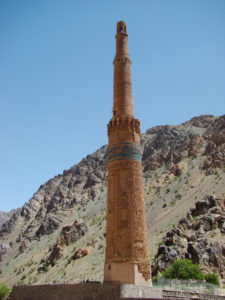Located in the remote and rugged province of Ghor in the west-central highlands of Afghanistan, the stunning Minaret of Jam is one of the country’s most important cultural treasures. But given its isolated location and the risks it currently faces, the monument is one that few people, Afghans or visitors, may ever have the opportunity to see up close. Read on to learn more about this architectural marvel, designated since 2002 as a UNESCO World Heritage Site.
What is the Minaret of Jam?
One of Afghanistan’s best-preserved examples of ancient architecture—and indeed the country’s first historic monument, according to some conservation experts—the breathtaking Minaret of Jam is the second-tallest brick minaret in the world. Built entirely of fired bricks, the structure resembles a fully extended telescope, with four staged columns of decreasing diameter sitting one inside the other. The minaret rests on an octagonal base roughly 9 meters in diameter, and rises to a total height of 65 meters (213 feet).
The outside of the monument is completely covered with highly detailed geometric designs in raised relief. A Kufic inscription inlaid in turquoise tiles adds a striking touch of color. Inside the minaret, a surprise awaits: a pair of staircases entwined in a double-helix pattern that echoes the form of a DNA molecule (a design that predates by hundreds of years the constructions that became popular in European towers during the Renaissance). This remarkable combination of beauty and practicality makes the Minaret of Jam one of the finest examples of both the artistic creativity and the structural engineering skill of its time.
How old is the monument?

Image courtesy Afghanistan Matters | Flickr
The Minaret of Jam is all the more astonishing in view of the fact that it is more than 800 years old. The monument was built in 1194 by Ghurid Sultan Ghiyas-od-din (1153-1203). Today, the minaret is the only remaining monument from the Ghurids, a civilization that dominated the region during the 12th century, ruling an empire that extended from Bengal to Iran. The capital of the Ghurid dynasty was the legendary city of Firozkoh, also called the Turquoise Mountain, which was described as the world’s most splendid city before it was destroyed by a descendant of Genghis Khan. The present-day site of Firozkoh has never been located, but some experts speculate that it may have been in the region around the minaret. Other remains in the area include vestiges of towers and castles from Ghurid settlements east of the minaret and on the banks of the Hari-rud River, and a group of 11th- and 12th-century stones with Hebrew inscriptions located on the Kushkak hill.
The Minaret of Jam was vital to the dissemination of innovative Islamic architecture and ornamentation, and it played a very important role in the development of art and architecture in Central Asia during the period following its construction. The Qutb Minar minaret, a red sandstone tower built just south of Delhi in the early 1300s, is a clear example of the Minaret of Jam’s influence.
According to some accounts, the minaret was forgotten about until its long shadow was spotted by a British aircraft flying over the Hari River gorge in the late 1950s. Archeologists first surveyed and recorded the site in 1957, and the minaret later enjoyed a period of time as a popular destination for intrepid international tourists, including British writers Peter Levi and Bruce Chatwin.
What risks is the monument facing?
In addition to illicit excavations and other potential conflict-related damage, the Minaret of Jam faces a number of serious environmental threats. Given its proximity to the Hari and Jam rivers, erosion and flooding remain constant dangers, as do the earthquakes that strike the region fairly frequently.
In 2013, the Minaret of Jam was placed on the list of “World Heritage Sites in Danger,” and reports from 2014 stated that the minaret was in serious danger of collapsing. For many years, the monument has been precariously tilting at an angle of about 3.47 degrees. For some context, the famous Leaning Tower of Pisa once tilted at an angle of 5.5 degrees, which was later reduced to 3.99 degrees after $25 million worth of emergency work. However, although the tilt of the Minaret of Jam is not as severe as that of its Italian cousin, the structure is 30 feet taller than the Tower of Pisa, built of far less sturdy material (fired bricks) than Pisa’s quarried stone, and positioned on a much less stable foundation. The top of the minaret is currently leaning more than 10 feet from vertical.
Despite concern from cultural preservation groups within and beyond Afghanistan, the future of the Minaret of Jam is not altogether certain. UNESCO has carried out some basic stabilization work over the years, including the construction of a new supporting wall, but the location and political climate of the area make it difficult to conduct the full extent of work necessary to preserve the minaret and the surrounding site. Activists hope that more donors will be found to boost conservation efforts by UNESCO and the government and ensure that this important reminder of Afghanistan’s cultural legacy is preserved for many future generations.

